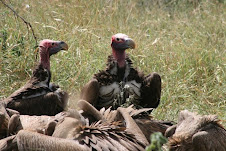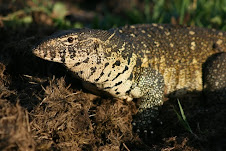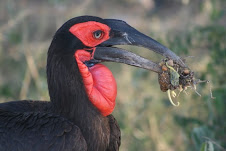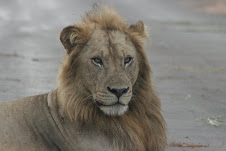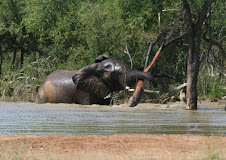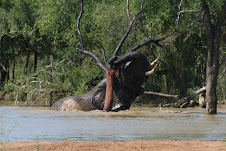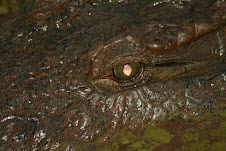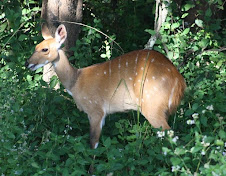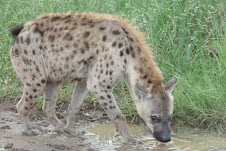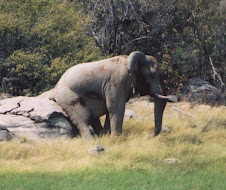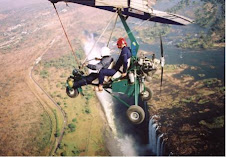Friday, 31 December 2010
SCORPION Owwwwww.!
On Monday I pulled a muscle in my back and then one of the social wasps decided it didn’t like me and stung me in the back. I have recovered from these now but on Tuesday night just before going to bed a small scorpion decided to have a go as well. I was watching a DVD when all of a sudden there was a sharp sting on my second toe on my left foot. Sh......t!!! I looked down to see a scorpion about 30mm long. Not wanting to be stung again he got the order of a size 11 boot. It was a strange sensation and one that I don’t want to go through again. There was no swelling or redness but I could feel the poison very slowly affecting my toe, and then it spread very slowly around my foot. It wasn’t really painful but as if the poison was like little explosions in my veins. Although I have never had Ricicles in my blood it was a bit like having them in your veins and them popping as the moved around. Can anyone explain what was happening. It was a bit worrying at first because I know some scorpions are deadly but luckily this one was apparently quite mild. I have read various articles on scorpion stings, about applying hot or cold water but decided to let it run its course until morning when if it didn’t improve I would go to the hospital. I collected the dead scorpion to keep for identification just in case things got worse. In the morning I talked to some of the locals and described what had happened and they told me not to worry and that the effects would wear off over a couple days and that they get stung every so often and have no after effects. They were right as today is Friday and all of the effects have now totally disappeared.
HARTMANN'S OR BURCHELL'S ZEBRA?


All is going well here in Kasungu. It has been a good week for game viewing and I have seen much of what is to be seen here including a small herd of elephants that came by the house, hippo, buffalo, Sable, Roan, zebra, hartebeest, reed buck, puku, common duiker, grysbok, vervet monkey, baboon and wart hog. I have pictures of elephant, bush pig and civet on the cameras and there have been reports of 5 wild dog 2 days ago. A builder that visits the park regularly also told me she had seen 2 prides of lion back in October. One pride consisted of 1 male, 4 females and a cub and the other was 1 male, 1 female and a cub. I assume these were the same lions as they were in the same area and only a few days apart. However it is good news as this demonstrates that they are still around and in some numbers. I have seen spoor of leopard but no actual sightings. Hyaena regularly come near to the house and can be heard ‘whooping’ away.
A couple of South Africans came to the park other day, Leon and Debbie, and stayed for 3 nights. We went for a drive and saw zebra. Although we saw some which were definitely Burchell’s zebra we also saw a small herd that might have been Hartmann’s zebra. Their face was different and had ‘reddy brown’ hair around the muzzle as well as the stripes looking different to the Burchell’s. If there are any experts out their please take a look at the photos and let me know what you think. If I get clearer pictures Ill post them when I can.
A couple of South Africans came to the park other day, Leon and Debbie, and stayed for 3 nights. We went for a drive and saw zebra. Although we saw some which were definitely Burchell’s zebra we also saw a small herd that might have been Hartmann’s zebra. Their face was different and had ‘reddy brown’ hair around the muzzle as well as the stripes looking different to the Burchell’s. If there are any experts out their please take a look at the photos and let me know what you think. If I get clearer pictures Ill post them when I can.
Saturday, 11 December 2010
MOZAMBIQUE SPITTING COBRA

When I came across this Mozambique spitting cobra it was head to head with a hamerkop in the near empty swimming pool at the lodge. The bird was after the tadpoles and the snake after the toads.
It can get out of the pool by climbing the ladder but I put a log into the pool for it to use to climb out of the pool. The workers came to see the snake and most were petrified by it. They say they are evil? This one was around 5 feet long so it must have been about fully grown and in really good condition. Other snakes I have seen recently are the Rhombic night adder, the spotted bush snake, python and the striped bellied sand snake.
It can get out of the pool by climbing the ladder but I put a log into the pool for it to use to climb out of the pool. The workers came to see the snake and most were petrified by it. They say they are evil? This one was around 5 feet long so it must have been about fully grown and in really good condition. Other snakes I have seen recently are the Rhombic night adder, the spotted bush snake, python and the striped bellied sand snake.
I decided to remove the snake from the pool last night as the water was quite cold and I had a feeling that the night watchman was going to kill the snake. I got quite a long stick and gently removed the cobra onto the grass beside the pool. I have never seen a Malawian run so fast! The snake disappeared in one direction and the man in the other.
Wednesday, 8 December 2010
LIFE GOES ON IN PARADISE
The rains are really setting in here now and the dambo is filling up again. This is good for the wildlife as it means they can find clean water everywhere however it is bad for animal viewing because it is difficult to get around the park and also means that the under growth is growing fast. A lot of animals that have been hiding under ground come out when the rains come so I expect to see spiders, frogs and snakes over the next few weeks.
The land rover is running well however when I did the shopping yesterday, 130km round trip, there was no fuel in town. How people make a living out here I don’t know as it can be very difficult to travel.
The solar panel for my electricity is ok but when the clouds come and it rains it doesn’t charge up the battery for the computer or camera batteries and although there is loads of water in the dambo the solar pump doesn’t work efficiently so the main storage tanks are low so there is a shortage of water to the houses. This also means the shower doesn’t work due to lack of water and wouldn’t be hot anyway due to lack of sun shine.
I have recently got more pictures of another leopard and also hyenas whose home ranges are about 30 km from the other leopards and hyenas that I have encountered. There have been no new sightings of the wild dogs and no reports of lion or cheetah anywhere.
The civet, bush pig and hippo turn up on my cameras regularly and last week, after trying to get his picture for 3 weeks, I finally got a video of the water mongoose that scours the fringes of the dambo most nights.
Yesterday one of the young fish eagles got a bit close to the water, while fishing, and ended up having to swim to the shore. The spur winged geese that where close by saw this as an opportunity for revenge and chased him across the lake. I am not quite sure what they would do if they really wanted to impose some damage upon him.
The land rover is running well however when I did the shopping yesterday, 130km round trip, there was no fuel in town. How people make a living out here I don’t know as it can be very difficult to travel.
The solar panel for my electricity is ok but when the clouds come and it rains it doesn’t charge up the battery for the computer or camera batteries and although there is loads of water in the dambo the solar pump doesn’t work efficiently so the main storage tanks are low so there is a shortage of water to the houses. This also means the shower doesn’t work due to lack of water and wouldn’t be hot anyway due to lack of sun shine.
I have recently got more pictures of another leopard and also hyenas whose home ranges are about 30 km from the other leopards and hyenas that I have encountered. There have been no new sightings of the wild dogs and no reports of lion or cheetah anywhere.
The civet, bush pig and hippo turn up on my cameras regularly and last week, after trying to get his picture for 3 weeks, I finally got a video of the water mongoose that scours the fringes of the dambo most nights.
Yesterday one of the young fish eagles got a bit close to the water, while fishing, and ended up having to swim to the shore. The spur winged geese that where close by saw this as an opportunity for revenge and chased him across the lake. I am not quite sure what they would do if they really wanted to impose some damage upon him.
PARADISE FLYCATCHER

I managed to get some really good photos of the paradise flycatcher making their nest near to one of the houses. This is the male building the nest. Also close to the lodge there is a nest with 2 chicks in. It looks like the mother feeds the chicks as the father cannot be seen.
STORY OF THE MATONDO




STORY OF THE MATONDO (Mopany Worm)
The moths that lay these eggs are 2 of the emperor moths. Shortly after laying several hundred eggs they hatch into caterpillars as seen below. The green caterpillar is locally caleed the Matondo and the spiky one is called the Vilungulungu. These grow incredibly quickly and can strip a 5 metre Julbernadia Globiflora tree of all of its leaves in a day. The local people from the camp and the local villages are allowed to harvest these caterpillars and in one day alone they collected in the region of 25,000kg. The caterpillars are placed in water for a couple of hours to kill them and then their insides are squashed out of them. If they are dried whole they are very bitter. They are then washed again and boiled until they change colour. They are then placed in the sun on mats to dry and then they can be eaten. Most will be re-cooked as a relish. Many of the dried caterpillars can be found for sale in the local market and can fetch about MK100 (40p) per cup full.
The darker and spiky caterpillars are considered more of a delicacy as most people don’t like collecting them because of their spikes.
Although a rough idea of numbers of the caterpillar collected are known the environmental impact has never been estimated. There are millions of caterpillars left each year to turn into moths and the trees do not seem to be damaged as they flourish in the park.
The other evening I had around 30 of the moths flying around in my house and most evenings I get various types of praying mantid, beetles, moths and stick insects. There are several geckos that run around all night long eating the smaller flies. It is fascinating to see then run across the ceiling. At the same time a large toad came visiting who presumably wanted to join in the feast. In the morning most are dead so I need to sweep up.
The moths that lay these eggs are 2 of the emperor moths. Shortly after laying several hundred eggs they hatch into caterpillars as seen below. The green caterpillar is locally caleed the Matondo and the spiky one is called the Vilungulungu. These grow incredibly quickly and can strip a 5 metre Julbernadia Globiflora tree of all of its leaves in a day. The local people from the camp and the local villages are allowed to harvest these caterpillars and in one day alone they collected in the region of 25,000kg. The caterpillars are placed in water for a couple of hours to kill them and then their insides are squashed out of them. If they are dried whole they are very bitter. They are then washed again and boiled until they change colour. They are then placed in the sun on mats to dry and then they can be eaten. Most will be re-cooked as a relish. Many of the dried caterpillars can be found for sale in the local market and can fetch about MK100 (40p) per cup full.
The darker and spiky caterpillars are considered more of a delicacy as most people don’t like collecting them because of their spikes.
Although a rough idea of numbers of the caterpillar collected are known the environmental impact has never been estimated. There are millions of caterpillars left each year to turn into moths and the trees do not seem to be damaged as they flourish in the park.
The other evening I had around 30 of the moths flying around in my house and most evenings I get various types of praying mantid, beetles, moths and stick insects. There are several geckos that run around all night long eating the smaller flies. It is fascinating to see then run across the ceiling. At the same time a large toad came visiting who presumably wanted to join in the feast. In the morning most are dead so I need to sweep up.
Subscribe to:
Comments (Atom)






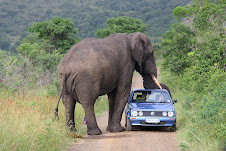.jpg)

